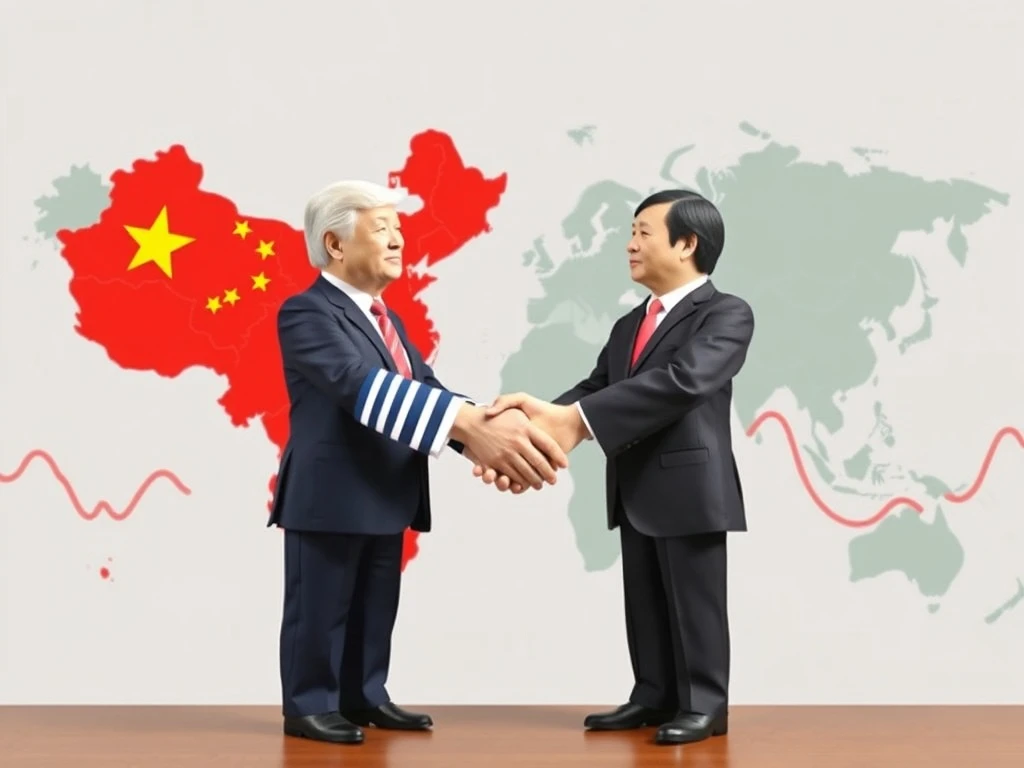The recent extension of the US-China trade truce marks a significant development. This crucial decision impacts businesses and investors worldwide. Many analysts view this as a positive step for economic stability. It offers a period of reduced tension between the two largest economies. Consequently, it influences various sectors from manufacturing to technology.
Understanding the US-China Trade Truce
The concept of a US-China trade truce emerged from a period of intense economic friction. Initially, the United States and China engaged in a protracted trade war. Both nations imposed significant tariffs on each other’s goods. This led to considerable uncertainty in global supply chains. Businesses faced higher costs and disrupted operations. For instance, American consumers saw increased prices on imported Chinese products. Similarly, Chinese exporters struggled with reduced demand from the U.S. market.
The first major de-escalation came with the “Phase One” trade deal in January 2020. This agreement saw China commit to purchasing more American goods. It also addressed intellectual property rights and currency practices. However, many tariffs remained in place. This deal did not fully resolve the underlying trade disputes. Instead, it provided a temporary pause. The recent extension continues this cautious approach. It prevents new tariffs from being imposed. Furthermore, it maintains open dialogue between the two economic giants. This ongoing communication is vital for future stability.
The Impact on Tariffs: What Remains?
A key question for businesses revolves around the status of existing tariffs. Despite the extended US-China trade truce, many punitive duties remain active. The Trump administration initially imposed these tariffs. They targeted billions of dollars worth of Chinese imports. For example, duties on steel and aluminum products are still in effect. Tariffs on a wide range of consumer goods also persist. This means that certain products continue to face higher import costs. Consequently, consumers may still pay more for these items.
However, the truce has a significant benefit. It prevents the imposition of *new* tariffs. This provides a measure of predictability for businesses. Companies can plan their supply chains without fear of sudden cost increases. It also signals a commitment to de-escalation. Both nations avoid further economic retaliation. Therefore, the current situation represents a holding pattern. Existing tariffs remain, but escalation is paused. This allows for ongoing negotiations. It offers a window for potential future reductions. The lack of new tariffs helps to stabilize the global trading environment. Businesses value this predictability immensely.
Economic Implications for Global Markets
The extension of the US-China trade truce offers a much-needed boost to global market confidence. Uncertainty often deters investment. This truce reduces that uncertainty. Consequently, investors react positively to stable trade relations. Stock markets generally see this as good news. For example, major indices often rise on such announcements. This stability helps to calm volatile sectors. It also encourages cross-border trade and investment. Many companies benefit from this predictable environment.
Specific sectors feel a direct impact. American agriculture, for instance, often benefits from Chinese purchases. The truce encourages China to fulfill its commitments. Technology companies also gain from reduced trade tensions. They rely heavily on complex global supply chains. Manufacturing industries, similarly, experience less disruption. This allows them to operate more efficiently. Reduced trade friction helps keep production costs stable. Moreover, it fosters an environment for economic growth. This positive sentiment extends beyond just the two nations. It influences economies worldwide. Therefore, the truce acts as a crucial pillar for global economic stability.
Political Drivers Behind the Extension
Both the United States and China have compelling reasons to extend the US-China trade truce. From the U.S. perspective, managing inflation remains a top priority. High tariffs can contribute to rising consumer prices. A truce helps alleviate some inflationary pressures. Furthermore, domestic political considerations play a role. A stable economy is often favored during election cycles. Avoiding new trade wars helps achieve this stability. The administration seeks to protect American jobs and industries. It also aims to ensure a predictable economic landscape for businesses.
China, too, benefits significantly from this pause. The nation faces its own economic challenges. Maintaining stability in trade relations is crucial for its growth targets. Avoiding further tariffs allows Chinese exporters to recover. It also helps stabilize their domestic employment situation. Moreover, China aims to project an image of global economic responsibility. A trade truce supports this narrative. Both governments recognize the mutual benefits of de-escalation. They understand the severe economic consequences of renewed conflict. Therefore, the extension reflects a shared interest in economic stability. It underscores a pragmatic approach to complex geopolitical issues. This strategic pause serves both nations’ immediate economic and political objectives.
Future Outlook for US-China Trade Relations
The extended US-China trade truce provides a window for continued dialogue. However, it does not guarantee a permanent resolution. The underlying issues remain complex. These include intellectual property theft, state subsidies, and market access. Both nations must address these core concerns. Future negotiations will likely focus on these areas. A comprehensive trade agreement could emerge. This would involve significant concessions from both sides. Alternatively, the truce could simply continue indefinitely. This would mean existing tariffs remain, but no new ones appear. Businesses must prepare for various scenarios.
Risks of renewed tensions persist. Geopolitical events or unforeseen disputes could derail progress. Therefore, vigilance remains essential. Companies should diversify supply chains where possible. They should also monitor policy changes closely. The future of global trade hinges significantly on these two powers. Their ongoing relationship shapes the international economic landscape. The current truce offers a chance for progress. It provides an opportunity to build trust. Ultimately, the long-term stability of the global economy depends on constructive engagement. This period of calm allows for strategic planning. It also encourages cautious optimism among market participants.
In conclusion, the extension of the US-China trade truce represents a vital, albeit temporary, relief. It prevents further tariff escalation. It also provides a much-needed period of stability for global markets. While core disagreements persist, this pause allows for continued diplomatic efforts. Businesses and investors should remain informed. They must adapt to evolving trade dynamics. This truce offers a crucial moment for reflection and strategic adjustment.
Frequently Asked Questions (FAQs)
What exactly is the US-China trade truce?
The US-China trade truce refers to an agreement between the United States and China to halt the escalation of their trade war. It prevents the imposition of new tariffs. It also maintains dialogue on existing trade issues. The current extension continues this period of de-escalation.
Are all tariffs between the US and China removed?
No, not all tariffs are removed. Many punitive duties imposed during the initial trade war remain in effect. The truce primarily prevents the addition of *new* tariffs. It aims to stabilize trade relations, not fully reverse past actions.
How does the trade truce impact global markets?
The trade truce generally brings positive sentiment to global markets. It reduces uncertainty for businesses and investors. This stability can lead to increased confidence. It also supports cross-border trade and investment. Specific sectors like agriculture and manufacturing benefit from reduced friction.
What are the main reasons for extending the US-China trade truce?
Both nations have strong economic and political incentives. The U.S. aims to manage inflation and maintain economic stability. China seeks to support its own economic growth and stabilize employment. Both recognize the mutual benefit of avoiding further economic conflict.
Will this truce lead to a permanent trade deal?
The truce creates an opportunity for a more comprehensive trade deal. However, it does not guarantee one. Underlying issues like intellectual property and market access remain. Future negotiations will determine if a lasting agreement can be reached. The current extension simply provides time for such discussions.
























